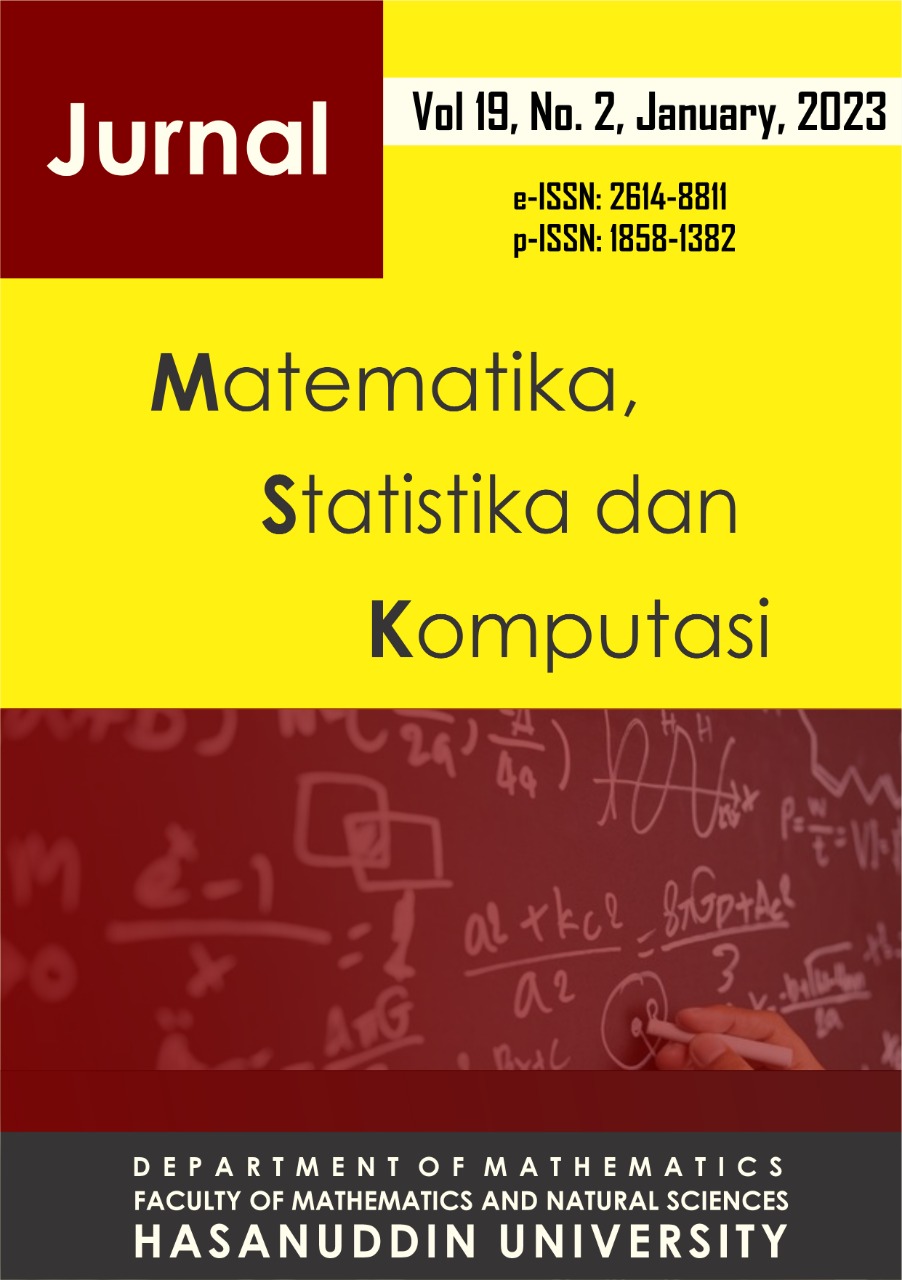Geographically Weighted Panel Regression Modelling of Human Development Index Data in East Kalimantan Province in 2017-2020
DOI:
https://doi.org/10.20956/j.v19i2.23775Keywords:
Adaptive Bisquare, Fixed Effect Model (FEM), Geographically Weighted Panel Regression (GWPR), Human Development Index (HDI)Abstract
Geographically Weighted Panel Regression (GWPR) model is a panel regression model applied on spatial data. This research applied Fixed Effect Model (FEM) on panel regression as the global model and GWPR as the local model for Human Development Index (HDI) regencies/municipalities in East Kalimantan Province data over the years 2017-2020. The aim of this research is to obtain the GWPR model of HDI data, as well as to acquire factors that influence it. The parameter of GWPR model was estimated on each observation location using the Weighted Least Square (WLS) method, namely Ordinary Least Square (OLS) with addition of spatial weighting. The spatial weighting on GWPR model was calculated using fixed bisquare, fixed tricube, adaptive bisquare and adaptive tricube. After the selection process, the optimum weighting function is adaptive tricube which provides a minimum Cross Validation (CV) value of 5.1419. Based on GWPR parameter testing, factors that affect HDI are local and diverse in each 10 regencies/municipalities in East Kalimantan Province. These factors are the labor force participation rate, number of health facilities, Gini ratio, population growth rate, open unemployment rate, poverty gap index and percentage of food expenditure. The coefficient of determination of the GWPR model obtains a value of 94.36% with the RMSE value of 0.1221.Downloads
References
Baeti, N., 2013. Pengaruh Pengangguran, Pertumbuhan Ekonomi dan Pengeluaran Pemerintah Terhadap Pembangunan Manusia Kabupaten/Kota di Provinsi Jawa Tengah Tahun 2007-2011. Economics Development Analysis Journal, Vol. 2, No. 3, 85-98.
BPS, 2014. Kalimantan Timur dalam Angka 2014. Samarinda: BPS Provinsi Kalimantan Timur.
BPS., 2020. Kalimantan Timur dalam Angka 2020. Samarinda: BPS Provinsi Kalimantan Timur.
Cao, K., Diao, M. & Wu, B., 2018. A Big-Data-based Geographically Weighted Regression Model for Public Housing Prices: A Case Study in Singapore. Annals of the American Association of Geographers, Vol. 109, No. 1, 173-186.
Fotheringham, A. S., Brunsdon, C. & Charlton, M., 2002. Geographically Weighted Regression: The Analysis of Spatially Varying Relationships. Chichester: Wiley.
Greene, W. H., 2007. Econometrics Analysis 6th Edition. New Jersey: Prentice Hall.
Gujarati, D. N., 2006. Ekonometrika Dasar. Jakarta: Erlangga.
Hidayat, M. J., Hadi, A. F. & Anggraeni, D., 2018. Analisis Regresi Data Panel Terhadap Indeks Pembangunan Manusia (IPM) Jawa Timur Tahun 2006-2015. Majalah Ilmiah Matematika dan Statistika, Vol. 18, No. 2, 69-80.
Hsiao, C., 2003. Analysis of Panel Data. New York: Cambridge University Press.
Jasasila., 2020. Pengaruh Tingkat Kemiskinan dan Jumlah Penduduk Terhadap Indeks Pembangunan Manusia (IPM) Kabupaten Batang Hari 2011-2019. Jurnal Ilmiah Ekonomi dan Bisnis, Vol. 11, No. 1, 40-44.
Melliana, A. & Zain, I., 2013. Analisis Statistika Faktor yang Mempengaruhi Indeks Pembangunan Manusia di Kabupaten/Kota Provinsi Jawa Timur dengan Menggunakan Regresi Panel. Jurnal Sains dan Seni Pomits, Vol. 2, No. 2, 237-242.
Meutuah, M. S., Yasin, H. & Maruddani, D. A. I., 2017. Pemodelan Fixed Effect Geographically Weighted Panel Regression untuk IPM di Jawa Tengah. Jurnal Gaussian, Vol. 6, No. 2, 241-250.
Nakaya, T., Fotheringham, A. S., Brunsdon, C. & Charlton, M., 2005. Geographically Weighted Poisson Regression for Disease Associative Mapping. Statistics in Medicine, Vol. 24, 2695-2717.
Ningrum, J. W., Khairunnisa, A. H. & Huda, N., 2020. Pengaruh Kemiskinan, Tingkat Pengangguran, Pertumbuhan Ekonomi dan Pengeluaran Pemerintah Terhadap Indeks Pembangunan Manusia (IPM) di Indonesia Tahun 2014-2018 dalam Perspektif Islam. Jurnal Ilmiah Ekonomi Islam, Vol. 6, No. 2, 212-222.
Pratama, A., Suyitno, & Purnamasari, I., 2021. Pemodelan Persentase Penduduk Miskin di Provinsi Kalimantan Timur Menggunakan Model Geographically Weighted Panel Regression. Jurnal Matematika dan Statistika serta Aplikasinya, Vol. 9, No. 2, 1-11.
Qur’ani, A. Y., 2014. Pemodelan Geographically Weighted Regression Panel (GWR-Panel) sebagai Pendekatan Model Geographically Weighted Regression (GWR) dengan Menggunakan Fixed Effect Model Time Trend. Jurnal Mahasiswa Statistik, Vol. 2, No. 3.
Raza, O., Mansournia, M. A., Foroushani, A. R. & Holakouie-Naeni, K., 2019. Geographically Weighted Regression Analysis: A Statistical Method to Account for Spatial Heterogeneity. Archives of Iranian Medicine. Vol. 22, No. 3, 155-160.
Rosadi, D., 2011. Analisis Ekonometrika dan Runtun Waktu Terapan dengan R. Yogyakarta: Andi.
Rustariyuni, S. D., 2014. Pengaruh Gini Ratio, Pengeluaran Non Makanan per Kapita, Belanja Daerah dan Laju Pertumbuhan Ekonomi pada Indeks Pembangunan Manusia Kabupaten/Kota di Provinsi Bali Periode 2004-2012. Jurnal Piramida, Vol. 5, No. 1, 45-55.
Setiawan & Kusrini., 2010. Ekonometrika. Yogyakarta: Andi.
Sifriyani, Mandang, I., Amijaya, F. D. T. & Ruslan, R., 2022. Developing Geographically Weighted Panel Regression Model for Spatio-Temporal Analysis of Covid-19 Positive Cases in Kalimantan, Indonesia. Journal of Southwest Jiaotong University. Vol. 57, No. 3, 113-126.
Wibisono, D., 2005. Metode Penelitian dan Analisis Data. Jakarta: Salemba Medika.
Woolridge, J. M., 2002. Econometrics Analysis of Cross-Section and Panel Data. London: MIT Press.
Yasin, H., 2011. Pemilihan Variabel pada Model Geographically Weighted Regression. Jurnal Program Studi Statistika FMIPA Universitas Diponegoro.
Downloads
Published
How to Cite
Issue
Section
License
Copyright (c) 2023 Author and publisher

This work is licensed under a Creative Commons Attribution 4.0 International License.

This work is licensed under a Creative Commons Attribution 4.0 International License.
Jurnal Matematika, Statistika dan Komputasi is an Open Access journal, all articles are distributed under the terms of the Creative Commons Attribution License, allowing third parties to copy and redistribute the material in any medium or format, transform, and build upon the material, provided the original work is properly cited and states its license. This license allows authors and readers to use all articles, data sets, graphics and appendices in data mining applications, search engines, web sites, blogs and other platforms by providing appropriate reference.








